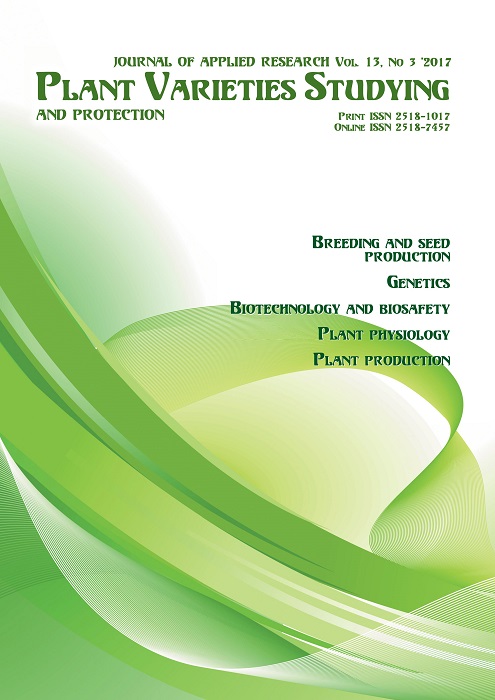Rice (<em>Oryza sativa</em> L.) blast resistance genes bioinformatic analysis
DOI:
https://doi.org/10.21498/2518-1017.13.3.2017.110708Keywords:
Genes Pib, Pi54, Pi4, sequence alignment, phylogenetic analysis, evolution, single nucleotide polymorphism, indelsAbstract
Purpose. To investigate rice blast resistance genes polymorphism by using bioinformatic methods.
Methods. Global and local nucleotide alignment, phylogenetic analysis, HyPhy test.
Results. For Pib gene, numerous single nucleotide substitutions and deletions of 1–3 bp were established. The phylogeny of this gene has been studied and homologues have been found both in various rice species and in other cereals. These sequences can encode proteins that «recognize» the phytopathogens effectors, and can also be associated with resistance to phytopathogens. The Pi4 gene is characterized by single nucleotide substitutions, insertions and deletions; the number of non-synonymous substitutions exceeds the number of synonymous ones. The Pi54 gene variability is significantly lower than that of the Pi4 and Pib genes. The predominant types of polymorphism were single nucleotide substitutions and small-sized indels. It was found that non-synonymous substitutions in Pi54, Pi4 and Pib genes were in close proximity, sometimes forming clusters, while some coding regions were either superconservative or contained predominantly synonymous substitutions. On philodendrograms, cultivated rice samples were clustered with samples of ancestral wild-growing species.
Conclusions. Evolution of the rice blast resistance genes Pi4, Pib and Pi54 is characterized by diversification selection. Considering that tense coevolution and significant rate of adaptation and creation of new pathogen races are typical for a plant and a parasite, these genes are subjected to intensive selection aimed at increasing diversity for obtaining the resistance to new races of the pathogen.
Downloads
References
Ashkani, S., Rafii, M., Shabanimofrad, M., Miah, G., Sahebi, M., Azizi, P., ... Nasehi, A. (2015). Molecular breeding strategy and challenges towards improvement of blast disease resistance in rice crop. Front. Plant Sci., 6, 1–14. doi: 10.3389/fpls.2015.00886
Dudchenko, V. V. (2015). Derzhavne zakonodavche rehuliuvannia rysovoho vyrobnytstva ta yoho naukove zabezpechennia v Ukraini [State legislative regulation of rice production and its scientific support inUkraine].Kherson: Ailant. [in Ukrainian]
Marone, D., Russo, M., Laidт, G., De Leonardis, A., & Mastrangelo, A. (2013). Plant nucleotide binding site–leucine-rich repeat (NBS-LRR) genes: Active guardians in host defense responses. Int. J. Mol. Sci., 14(4), 7302–7326. doi: 10.3390/ijms14047302.
Integrated Rice Science Database Oryzabase. Retrieved from https://shigen.nig.ac.jp/rice/oryzabase/
Chen, X., & Ronald, P. (2011). Innate immunity in rice. Trends Plant Sci., 16(8), 451–459. doi: 10.1016/j.tplants.2011.04.003
Divya, B., Biswas, A., Robin, S., Rabindran, R., & Joel, A. (2014). Gene interactions and genetics of blast resistance and yield attributes in rice (Oryza sativa L.). J. Genet., 93(2), 415–424. doi: 10.1007/s12041-014-0395-7
Halaiev, O., Halaieva, M., & Shpak, D. (2015). Detection of racespecific genes of resistance to piryculariosis Pi-ta and Pi-b in rice varieties (Oryza sativa L.). Zbirnyk naukovykh prats SHI–NTsNS [Collected scientific articles of PBGI–NCSCI], 25, 120–128. [in Ukrainian]
National Center for Biotechnology Information Database. Retrieved from http://www.ncbi.nlm.nih.gov/
Smith, S., & Waterman, M. (1981). Identification of common molecular subsequences. J. Mol. Biol., 147(1), 195–197.
Needleman, S., & Wunsch, C. (1970). A general method applicable to the search for similarities in the amino acid sequence of two proteins. J. Mol. Biol., 48(3), 443–453.
Edgar, R. (2004). MUSCLE: multiple sequence alignment with high accuracy and high throughput. Nucleic Acids Res., 32(5), 1792–1797. doi: 10.1093/nar/gkh340
Sneath, P., & Sokal, R. (1973). Numerical taxonomy: The principles and practice of numerical classification.San Francisco: W. H. Freeman & Co.
Kosakovsky Pond, S. L., Frost, S. D. W., & Muse, S. V. (2005). HyPhy: hypothesis testing using phylogenies. Bioinformatics, 21(5), 676–679. doi: 10.1093/bioinformatics/bti079
Muse, S. V., & Gaut, B. S. (1994). A likelihood approach for comparing synonymous and nonsynonymous nucleotide substitution rates, with application to the chloroplast genome. Mol. Biol. Evol., 11(5), 715–724.
Felsenstein, J. (1981). Evolutionary trees from DNA sequences: a maximum likelihood approach. J. Mol. Evol., 17(6), 368–376.
Kosakovsky Pond, S. L., & Frost, S. D. Not so different after all: A comparison of methods for detecting amino acid sites under selection. Mol. Biol. Evol., 22(5), 1208–1222. doi: 10.1093/molbev/msi105
Downloads
Published
How to Cite
Issue
Section
License
Copyright (c) 2017 Ukrainian Institute for Plant Variety Examination

This work is licensed under a Creative Commons Attribution-ShareAlike 4.0 International License.
Starting in 2022, the copyright to the publication remains with the authors
Our journal abides by the CREATIVE COMMONS copyright rights and permissions for open access journals.
Authors, who are published in this journal, agree to the following conditions:
- The authors reserve the right to authorship of the work and pass the first publication right of this work to the journal under the terms of a Creative Commons Attribution License, which allows others to freely distribute the published research with the obligatory reference to the authors of the original work and the first publication of the work in this journal.
- The authors have the right to conclude separate supplement agreements that relate to non-exclusive work distribution in the form in which it has been published by the journal (for example, to upload the work to the online storage of the journal or publish it as part of a monograph), provided that the reference to the first publication of the work in this journal is included.

























 Ukrainian Institute for Plant Varieties Examination
Ukrainian Institute for Plant Varieties Examination  Селекційно-генетичний інститут
Селекційно-генетичний інститут Institute of Plant Physiology and Genetics of the National Academy of Sciences of Ukraine
Institute of Plant Physiology and Genetics of the National Academy of Sciences of Ukraine
 The National Academy of Agrarian Sciences of Ukraine
The National Academy of Agrarian Sciences of Ukraine